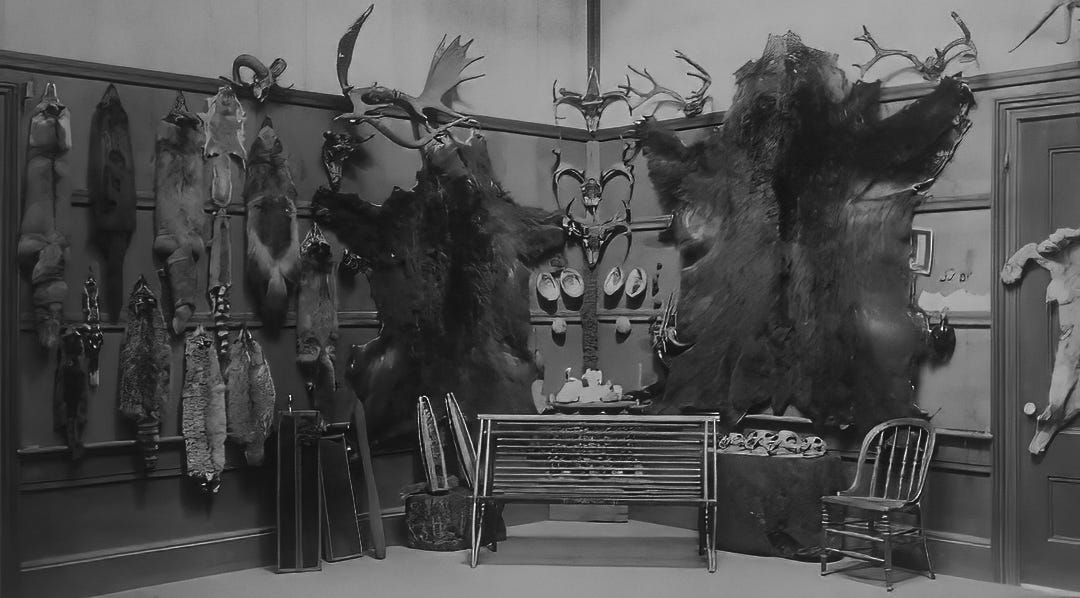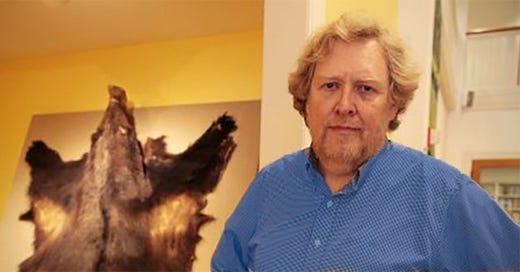YOSEMITE STORIES

Hunting the bear
IN AN EXTRAORDINARY 1918 letter, a rancher named Robert Wellman recounted how he and a friend had killed one of Yosemite’s last two Grizzly bears thirty years earlier. Using a dead cow as bait, Wellman had lured the bear below a tree platform he’d built. From there, he shot and wounded the bear, and then climbed down the tree to finish him off.
“My rifle barked, sending a ball under the base of his ear,” Wellman wrote. “He rolled over on his side [and] a few convulsive struggles shook his frame. He raised one huge fore arm and waved it back and forth a few times. Then it dropped. The King of the Sierra was dead. We gazed on the prostrate beast for some moments in silence.”
Nearly 130 years after the bear was slain, I tracked down his pelt and put it on public display.
Wellman sent his hand-written letter to Joseph Grinnell, the founder and director of the Museum of Vertebrate Zoology at UC Berkeley, who had requested the account. Starting in the early twentieth century, Grinnell and his successors continually collected vertebrate pelts and skeletons in California, meticulously recording their findings in thousands of blue notebooks that line one of the museum’s walls.
A pioneer of the science of ecology, Grinnell had long warned against eliminating the Grizzly bear and other top predators. Ten thousand once roamed the state. Though the iconic bear still graces the state flag, the last recorded California Grizzly was killed in 1922, three years after Wellman wrote his letter.
While researching materials for a Yosemite exhibit at the California Historical Society, I discovered Grinnell’s correspondence with Wellman in the university library. From my days as an editor on campus, I’d also become acquainted with the field biologists at the museum. I’d even gone with them on a field trip to Yosemite, where I learned to trap and skin voles.
The vole-sized specimens are collected in metal drawers in the museum, but larger animals are housed in a climate-controlled storage facility, where their fresh carcasses are cleaned by insects and their skins labeled and hung. Aware of Grinnell’s tenacity, I strongly suspected Wellman’s Grizzly was there. But when I asked my friends at the museum, they grumbled about finding a particular pelt among the hundreds hanging in storage.
In the end, though, they did find the bear. Grinnell, it turned out, had acquired the skin from artist Thomas Hill, who had bought it from Wellman and hung it in his Yosemite studio. From Berkeley, the bear made its way to our exhibit in San Francisco, where we also displayed Wellmans’ letter and retold the whole story. Reporting on the exhibit, the San Francisco Chronicle published my picture alongside the Grizzly in the Sunday paper. Despite a careful inspection of the skin, though, I never did detect the holes where Wellman shot him.
The multimedia ebook I created for the exhibit, Yosemite: A Storied Landscape, is a free download in Apple Books. It includes the Wellman letter.
LOVE AFFAIRS
Am I a nut?
By Barbara Ramsey
MURAT ERDEM IS A NUT SELLER in eastern Turkey. He styles himself after Turkish pop stars of the 70’s and 80’s and is especially taken with singers who wore their hair, mustaches, and wide collars in the manner of the Florida drug lords on Miami Vice.
I absolutely love him.
Two weeks ago, I had zero interest in nut sellers, Turkish singers, or Miami Vice. Two weeks ago you couldn’t have convinced me that I would ever, in a million years, put the TikTok app on my phone. But then my sister sent me a video clip of Murat. He was standing in the aisle next to some pistachios. A thirty-year-old Turkish pop song was playing in the background and Murat was swaying to the music, occasionally lip synching the words. As he looked directly into the camera, I fell under his spell.
Murat is a medium-sized man of about forty. His dark hair (or wig?) is carefully styled into a Prince Valiant cut. He uses guy-liner and waxes his mustache. In my starter video, he wears a bright orange jacket with matching orange shoes, a black shirt open halfway to the waist, conservative black pants, and a conspicuous gold watch. Though I don’t know his sexual persuasion, his vibe feels like Castro District meets Istanbul.
But these are mere surface details. His appeal is in the soulful looks he gives the camera, his small hand gestures and head bobbles, and most of all his winks. As he moves in time to the music, he looks into the camera and oh-so-slowly winks at his viewers. He frequently puts his hand over his heart and then points directly at… YOU!
In a gesture I’d never seen before, he gathers his fingers and points them towards his heart, turns his hand, and suddenly shoots out all five fingers, as if his hand is throwing a kiss. Most videos last no more than a minute and combine his stereotyped movements with a small range of classic Turkish Top 40 tunes. That’s it.
Yet over the past several years Murat has built quite a fanbase, with 180,000 followers on Instagram. Small by internet standards, his fan numbers are stratospheric for a Turkish nut seller whose only assets are his wink and the 165 suits he owns. He’s a celebrity in Turkey and Greece and has devotees across the globe with, oddly, a particularly large following in Brazil. One Brazilian explained: “We are a people who cannot resist this much seduction.”
In their social media comments, admirers’ endearments include “Brother”, “the King”, “Our dear Ottoman”, and “bebegim”—Turkish for baby. Many simply refer to him as “my husband”, as in “I wait for you here in Rio, my husband.” Google translations of the multilingual comments include the profane (“Just open one more button of the shirt, bebegim!”) and the sublimely mistranslated (“I hope one day I will achieve this skin of elegance!”).
Some fans create Murat “reaction” videos. Most are men who film themselves in split-screen videos that run alongside the real Murat videos. They show the men seemingly catching Murat’s eye and reacting to his winks, often by being shocked. Other times, they act pleased by his attention. I’m not sure quite what to make of them, but clearly these guys are playing with Murat’s aura of same-sex attraction.
On Tik-Tok there are two Murat Erdem profiles, both with many, many videos. One is simply “Murat Erdem” and the other is “Murat Erdem Impressions”. A wide range of people—men and women, fat and thin, young and old, dark and blond—do the impressions. Many, especially women, wear fake mustaches. There are hundreds of them and in every one I’ve watched, the person is earnestly imitating Murat as closely as possible.
These imitators are not making fun of him. Their videos are homages. One woman provides her own voice-over describing how hard it is to duplicate his exquisitely timed winks. And like her, I not only love him, but choose to believe that Murat loves me back.
OUR ESTEEMED panel of judges (me) declared Linda Okazaki the winner of our recent photo caption contest. The panel noted her submission’s alliteration, attention to the young woman’s superb fashion sense, and its tongue-in-cheekiness regarding a color photograph. Linda wrote: "Black and white is always right." Honorable mentions to Ralph Bell and Rachel Rutledge, and a reminder that this picture will be included at the Print Night Exhibit at The Meadwerks in Port Townsend in November. Thanks everyone!
Snippets
A LETTER FROM the Marquis de Sade, written while in prison to his “prim and decorous” wife, Renée-Pélagie de Sade, introduces a 1998 profile of her by Francine du Plessix Gray in the New Yorker. I’ve never truly understood the fascination with de Sade, but when I ran across the article about his wife on the magazine’s site, I clicked through. And I can’t resist sharing the letter’s purple prose:
Rest assured, soul of my soul, that the first little errand I will make upon being sprung, my very first action as a free man, after kissing your eyes, your nipples and your buttocks, will be to purchase . . . the totality of the works of Montaigne . . . Voltaire, J.-J. Rousseau. . . . And don’t be so stingy about my little dizzies. . . . Could one or two bottles of peach wine, mon fan-fan, subvert the Salic law, or threaten the Justinian code? Hark ye, Minerva’s favorite, only a drunkard should suffer such a refusal: but I who am solely inebriated by your charms and am never sated by them, O you Olympian ambrosia, shouldn’t be denied a little peach wine. . . . Flame of my life, when, when will your alabaster fingers come to exchange the irons of [my jailer] for the roses of your breast? Adieu, I kiss you and go to sleep. This 24th of November, 1783, at 1 A.M.
According to du Plessix Gray, who wrote a book about de Sade, his abuse and depravities included seducing his wife’s younger sister, a nun. Overlooking his cruelties, Renée-Pélagie remained surprisingly loyal to her husband almost to the end. But by the time he was finally released from prison by Robespierre in 1790, she had joined a convent, refused to see him, and filed for divorce.
PLEASE DON’T MAKE ME download another app, writes Ian Bogost in the Atlantic:
Our app-ocalypse is much too far along already. Every crevice of contemporary life has been colonized. At every branch in your life, and with each new responsibility, apps will keep sprouting from your phone. You can't escape them. You won’t escape them, not even as you die, because—of course—there’s an app for that too.
Despite her new TikTok addiction, Barbara also lashed out at our digital overlords in her recent What’s Bugging Barbara? column.









Yes, who are the engineers and designers of these devices? My microwave reads Defrost, Weight Defrost, Power, Clock, Kitchen Timer, Popcorn, Potato, Pizza, Frozen Vegetable, Beverage, Dinner Plate, Express cook, 1, 2, 3, 4, 5. 6, 7, 8, 9, 0 Pause, Off. Don't get me going on security questions for financials. What was the name of your first pet. first car you drove, kindergarten teacher, favorite color and so on? How old are those deciding these questions? Don't they know the names of things are the first to go?